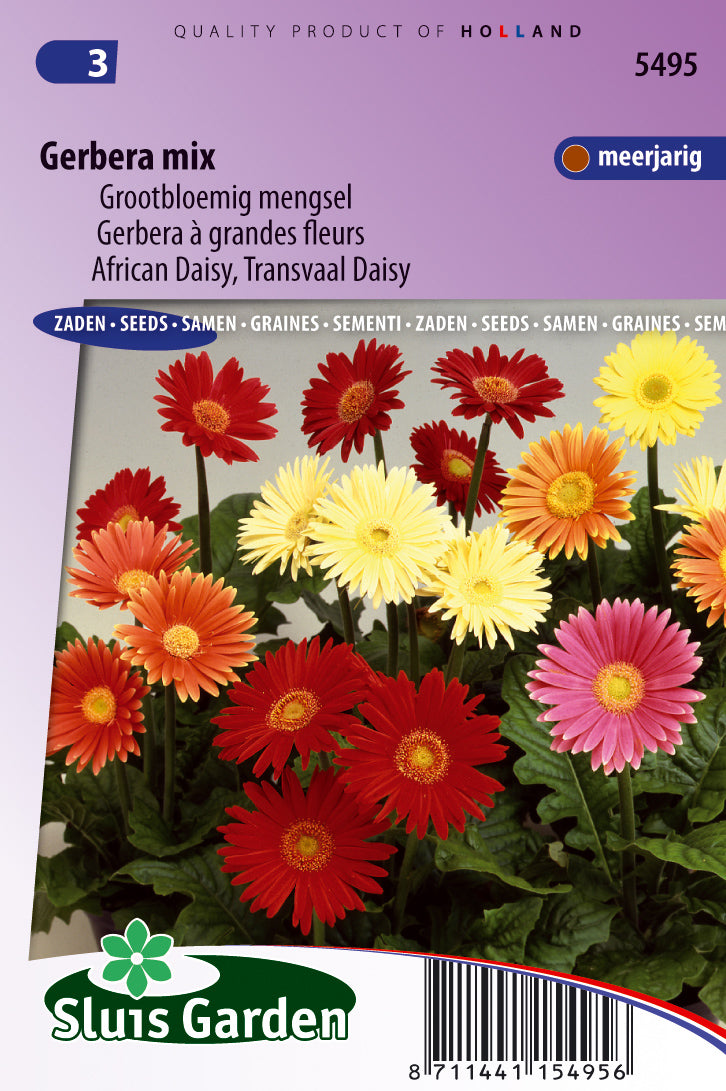1
/
of
1
Gerbera jamesonii Australian Giants
Gerbera jamesonii Australian Giants
Regular price
1.350 KWD
Regular price
Sale price
1.350 KWD
Unit price
/
per
Shipping calculated at checkout.
Couldn't load pickup availability
Gerbera jamesonii, commonly known as Gerbera Daisy or Transvaal Daisy, is a popular flowering plant known for its vibrant and large flowers. The Australian Giants variety typically produces larger blooms. Here's a guide on how to grow Gerbera jamesonii 'Australian Giants':
**1. Sunlight:**
- Gerbera Daisies thrive in bright, indirect sunlight. Plant them in a location where they receive at least 6 hours of filtered sunlight daily.
**2. Soil:**
- Use well-draining, loamy soil with a slightly acidic to neutral pH. Good drainage is crucial to prevent root rot.
**3. Planting Time:**
- Plant Gerbera Daisies in the spring or fall. Ensure the threat of frost has passed before planting.
**4. Planting Depth:**
- Plant Gerbera Daisies at the same depth they were in their nursery containers. Avoid burying the crown, which is where the leaves meet the roots.
**5. Spacing:**
- Space Gerbera plants about 12 to 18 inches apart to allow for good air circulation.
**6. Watering:**
- Keep the soil consistently moist but not waterlogged. Water the plants at the base to prevent fungal diseases. Avoid wetting the foliage.
**7. Mulching:**
- Apply a layer of organic mulch around the plants to retain soil moisture and suppress weeds. Mulch also helps regulate soil temperature.
**8. Fertilization:**
- Fertilize Gerbera Daisies every 4-6 weeks during the growing season with a balanced, water-soluble fertilizer. Follow the package instructions for application rates.
**9. Deadheading:**
- Remove spent flowers regularly to encourage continuous blooming. This also prevents the plant from putting energy into seed production.
**10. Pruning:**
- Prune off any yellow or dead leaves to maintain the plant's appearance. Cut back spent flower stems to encourage new growth.
**11. Support:**
- Provide support for the plants if they become top-heavy with large flowers. Staking may be necessary to prevent the stems from bending.
**12. Pests and Diseases:**
- Keep an eye out for aphids and spider mites. Treat any infestations promptly. Good air circulation helps prevent fungal diseases.
**13. Winter Care:**
- In colder climates, Gerbera Daisies may be treated as annuals or brought indoors during the winter. Provide a layer of mulch around the base for insulation.
**14. Companion Planting:**
- Gerbera Daisies are well-suited for mixed flower beds and containers. They pair well with other sun-loving perennials.
By following these guidelines, you can grow Gerbera jamesonii 'Australian Giants' and enjoy its large, colorful blooms in your garden. Adjustments may be needed based on your local climate and soil conditions.
**1. Sunlight:**
- Gerbera Daisies thrive in bright, indirect sunlight. Plant them in a location where they receive at least 6 hours of filtered sunlight daily.
**2. Soil:**
- Use well-draining, loamy soil with a slightly acidic to neutral pH. Good drainage is crucial to prevent root rot.
**3. Planting Time:**
- Plant Gerbera Daisies in the spring or fall. Ensure the threat of frost has passed before planting.
**4. Planting Depth:**
- Plant Gerbera Daisies at the same depth they were in their nursery containers. Avoid burying the crown, which is where the leaves meet the roots.
**5. Spacing:**
- Space Gerbera plants about 12 to 18 inches apart to allow for good air circulation.
**6. Watering:**
- Keep the soil consistently moist but not waterlogged. Water the plants at the base to prevent fungal diseases. Avoid wetting the foliage.
**7. Mulching:**
- Apply a layer of organic mulch around the plants to retain soil moisture and suppress weeds. Mulch also helps regulate soil temperature.
**8. Fertilization:**
- Fertilize Gerbera Daisies every 4-6 weeks during the growing season with a balanced, water-soluble fertilizer. Follow the package instructions for application rates.
**9. Deadheading:**
- Remove spent flowers regularly to encourage continuous blooming. This also prevents the plant from putting energy into seed production.
**10. Pruning:**
- Prune off any yellow or dead leaves to maintain the plant's appearance. Cut back spent flower stems to encourage new growth.
**11. Support:**
- Provide support for the plants if they become top-heavy with large flowers. Staking may be necessary to prevent the stems from bending.
**12. Pests and Diseases:**
- Keep an eye out for aphids and spider mites. Treat any infestations promptly. Good air circulation helps prevent fungal diseases.
**13. Winter Care:**
- In colder climates, Gerbera Daisies may be treated as annuals or brought indoors during the winter. Provide a layer of mulch around the base for insulation.
**14. Companion Planting:**
- Gerbera Daisies are well-suited for mixed flower beds and containers. They pair well with other sun-loving perennials.
By following these guidelines, you can grow Gerbera jamesonii 'Australian Giants' and enjoy its large, colorful blooms in your garden. Adjustments may be needed based on your local climate and soil conditions.
Share

